The grand parade of suffragettes in 1913 was a turning point in women's struggle for the right to vote, despite the abuse by thousands of men who blocked their route.
-
Spring 2024
Volume69Issue2
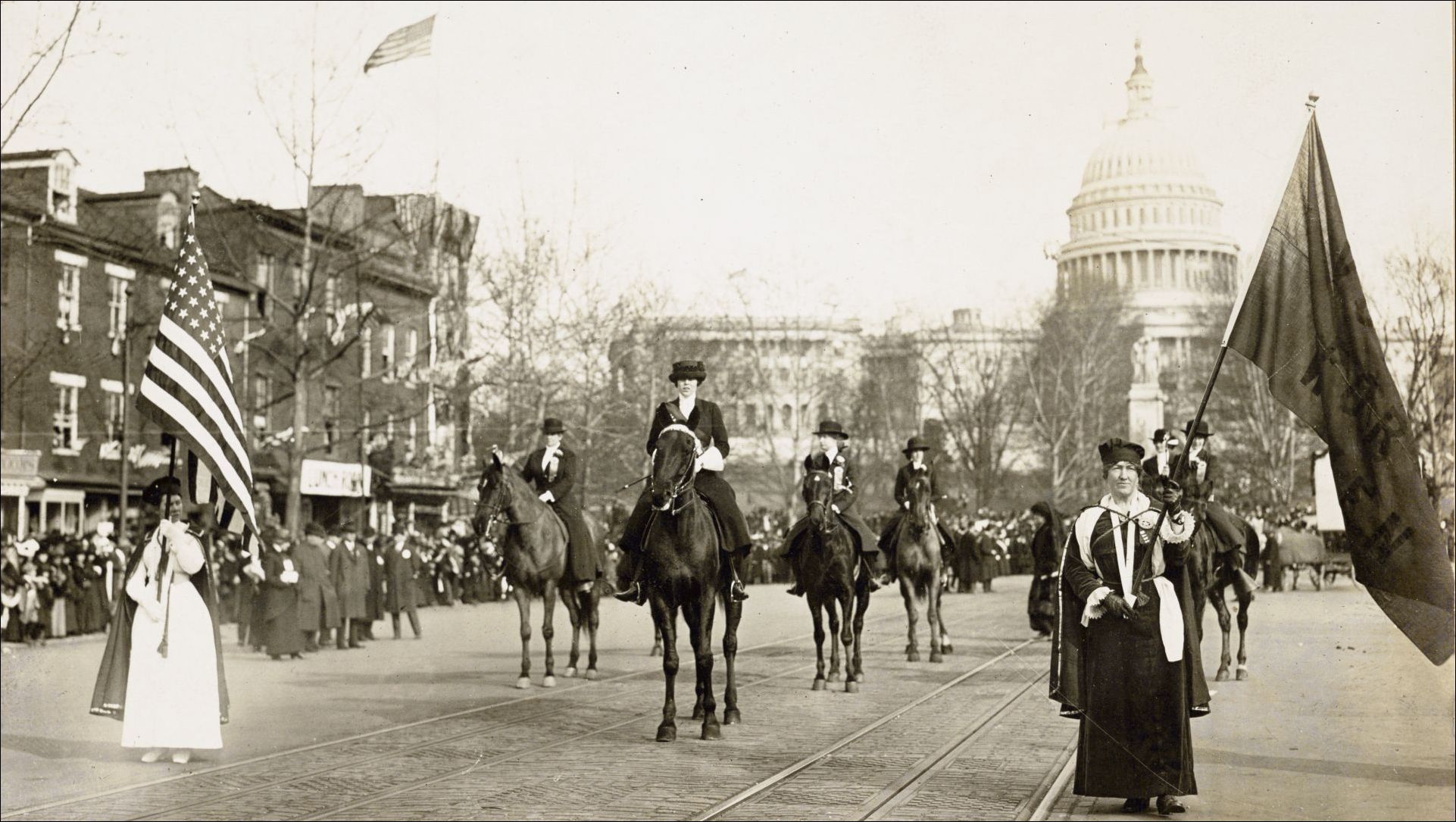
Editor's Note: Elisabeth Griffith is the author of two acclaimed books on women's history, Formidable: American Women and the Fight for Equality: 1920–2020 and In Her Own Right: the Life of Elizabeth Cady Stanton. She has a PhD in history.
On March 3, 1913, women chosen for their good looks and equestrian skills led the first women’s march in Washington, D.C. on the day before Democrat Woodrow Wilson’s presidential inauguration. First came the grand marshal, May Burleson, a Texas beauty wearing a black habit and riding a black horse. Next rode a stunning medieval-style queen, her hair unbound, her cape flowing; she wore Cossack pants and tall kid boots, as she sat astride a white steed, a “grand ecstasy in white,“ according to one reporter. She was New York labor lawyer Inez Milholland, annoyed to be known more for her beauty than her brains. A banner declared the parade’s purpose: “We demand an amendment to the Constitution of the United States enfranchising the women of this country.“
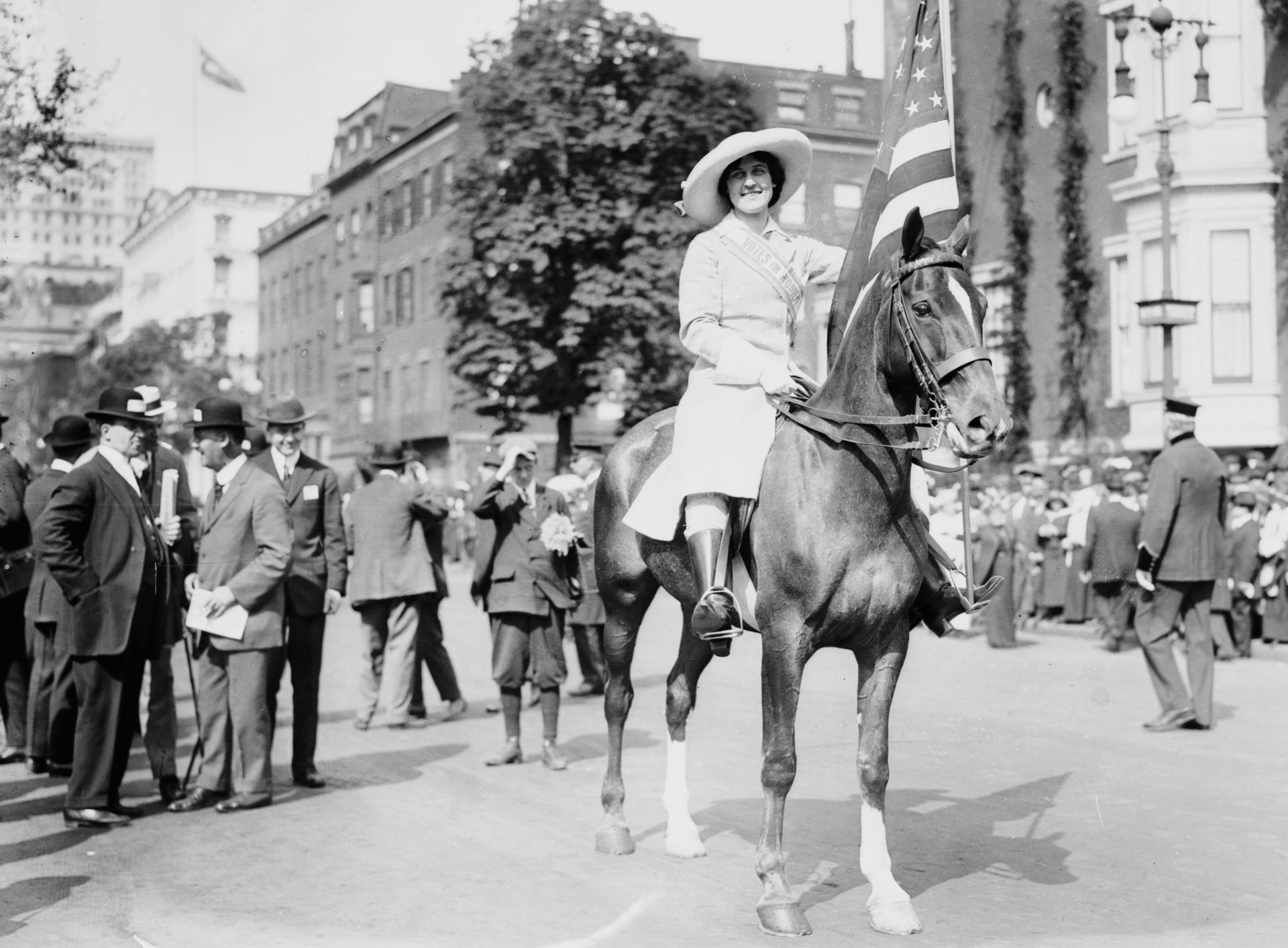
Three heralds, four mounted brigades, nine bands, 24 floats, and 5,000- 8,000 women followed. They lined up in sections and columns of four across. Instructed “to march steadily in a dignified manner and not to talk or wave," they planned to proceed down Pennsylvania Avenue from the Capitol to the Treasury Building, then to the White House, and on to the newly completed Continental Hall on 17th Street.
They barely made it four blocks before a drunken mob stampeded into the street. Still, the demonstration was deemed a brilliant success. As the front page of the Washington Post declared, “Woman’s Beauty, Grace, and Art Bewilder the Capital; Miles of Fluttering Femininity Present Enhancing Suffrage Appeal. “
The event was the brainstorm of Alice Paul, a diminutive Quaker academic from Camden, New Jersey. After graduating from Swarthmore with a biology degree in 1905 and enrolling in a master’s program at the University of Pennsylvania, she moved to England for further study.
Enthralled by the British suffragist Cristobel Pankhurst’s speeches, Alice Paul joined the rallies and riots organized by Cristobel’s mother, Emmeline Pankhurst, head of the Women’s Social and Political Union (WSPU), the radical branch of the British suffrage movement. Millicent Fawcett led the more-moderate National Union of Women’s Suffrage Societies, with 50,000 members. Her statue, the only one of a woman in London’s Parliament Square, was erected in 2018 to mark the centennial of suffrage for British women. In 1918, women had to be university graduates, property owners, married, or age 30 to vote.
Read our interview of Alice Paul, “I Was Arrested, Of Course,“
in the February 1974 issue of American Heritage
The WSPU motto was “Deeds, Not Talk.” Pankhurst’s troops demonstrated, broke windows, bombed mailboxes, and risked civilian lives. The doe-eyed Alice Paul was arrested seven times, jailed three times, and force-fed twice daily for four weeks, through a jaw clamps and rubber tubing. Returning to the United States in 1909 in precarious health and with a prison record, she began a doctorate in sociology at Penn. She found the American suffrage movement moribund.
She was not the only frustrated expatriate. Harriot Stanton Blatch, one of Elizabeth Cady Stanton’s seven children, had married an Englishman in 1882. Returning to New York after 20 years, Blatch was appalled to find the suffrage movement “in a rut . . . It bored its adherents and repelled its opponents . . . Our vital idea had been smothered by uninspired methods.”
To recharge the movement, Ms. Blatch welcomed Mrs. Pankhurst to New York, launched an equality league, recruited both wealthy and working-class supporters, and held rallies. Blatch invited black women to join her in one of the first suffrage parades, in New York City in 1907.
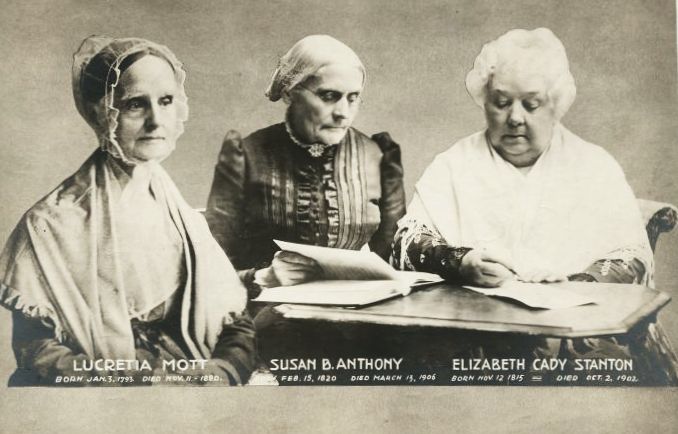
The suffrage campaign entered the 20th century in disarray. Its founding mothers were dying: Lucy Stone in 1893, Stanton in 1902, and Susan B. Anthony in 1906. Anthony had handpicked her successors to preside over the National American Woman Suffrage Association (NAWSA). Carrie Chapman Catt served from 1900 to 1904, when she resigned to care for her dying husband. Anna Howard Shaw, in office from 1904 to 1915, was a brilliant speaker, but a poor manager. The treasurer ran operations from Ohio. NAWSA had no national headquarters until Catt opened an office in New York City in 1915.
Having abandoned action on a federal amendment, NAWSA no longer had a presence in Washington. Its Congressional committee had an annual budget of ten dollars to host teas for Congressional wives. Between 1896 and 1910, no new state had endorsed women's suffrage and six referendums had lost.
During her first term, Carrie Catt replaced rhetoric about equality with arguments about expedience. Women needed the vote to contribute to the public good. Mothers would undertake “municipal housekeeping.” If politics was dirty and immoral, women would clean it up - a daunting prospect for party bosses. To expand its reach to working women, NAWSA stopped supporting “educated suffrage” and forged an alliance with trade unions. To build membership and loyalty, Catt insisted on lavish annual conventions with bunting, flags, flowers, and music. As a former journalist, she recognized what made good copy. Her goal was to normalize the image of suffragists, in contrast to their caricature as harridans.
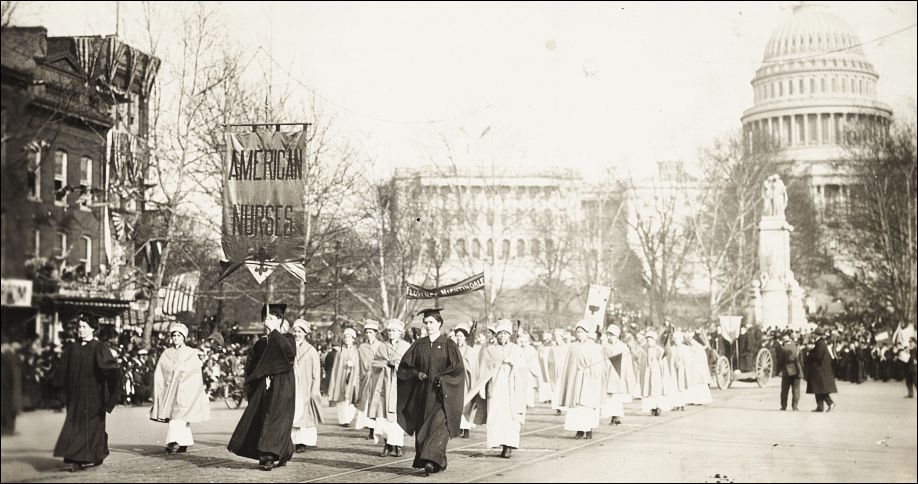
Another, more liberal cohort of suffragists were first-generation college-educated white women. Many were drawn to the settlement-house movement. These early social workers lived in urban slums among immigrants and the working poor, investigating factory conditions and offering practical programs like childcare and English classes. Already lobbying state legislators, these reformers recognized that the vote would empower them to press their progressive agenda.
NAWSA did not ally with African American activists. Black women had been the founders and members of suffrage organizations since the era of abolition. But, other than Sojourner Truth, few were acknowledged. Stanton did not include them in her six-volume History of Woman Suffrage, though Harriet Forten Purvis, Angelina Weld Grimke, Charlotte Forten Grimke, Sarah Redmond, Mary Ann Shadd Cary, Frances Ellen Watkins Harper, Josephine St. Pierre Ruffin, Anna Cooper, and many others played essential roles. No one could overlook Margaret Murray Washington and Adela Hunt Logan, senior administrators at the Tuskegee Institute, or Ida B. Wells and Mary Church Terrell, principals in the National Association of Colored Women (NACW), all of them unwelcome members of NAWSA. Like white suffragists, these were educated, middle- class women. They were committed to “racial uplift.” Mary Terrell emphasized the self-interest of black women in securing suffrage to end lynching.
In 1910, Alice Paul and Harriet Blatch appeared at the NAWSA’s annual meeting in Washington to endorse “outdoor tactics.” Paul reported on the British movement and Blatch took volunteers to Pennsylvania Avenue to demonstrate the challenges of speaking outdoors. Most members considered street tactics vulgar, although one conceded that they might add “a little more gusto.” Younger suffragists included the feisty duo in various state campaigns.
Old and new tactics combined to bring Washington state into the suffrage column by a margin of two-to-one in 1910, ending 14 years of inaction or defeat. After California became the sixth state to pass suffrage, in 1911, the National Association Opposed to Woman Suffrage reminded the public that the true test of suffrage support was not geography, but population. “Women's suffrage has been adopted only by the crude, raw, half-formed commonwealths of the sagebrush and windy plains,” declared one antagonist, “whence have come . . . foolish and fanatical politics . . . for a generation.”
Read how the first state approved the female vote in “It All Began in Wyoming”
by Lynne Cheney in the April 1973 issue of American Heritage
Even with women voting in six states, with 37 electoral-college votes (Wyoming, Colorado, Utah, Idaho, Washington, and California), suffrage was an insignificant factor in the 1912 presidential campaign. It was a four-way race, among Republican incumbent President William Howard Taft; New Jersey Governor Woodrow Wilson, the Democratic nominee; former president Theodore Roosevelt, running as a third-party “Bull Moose” progressive; and the socialist Eugene Debs. The major party platforms were silent on suffrage, but progressives and socialists advocated “equal suffrage for men and women alike.”
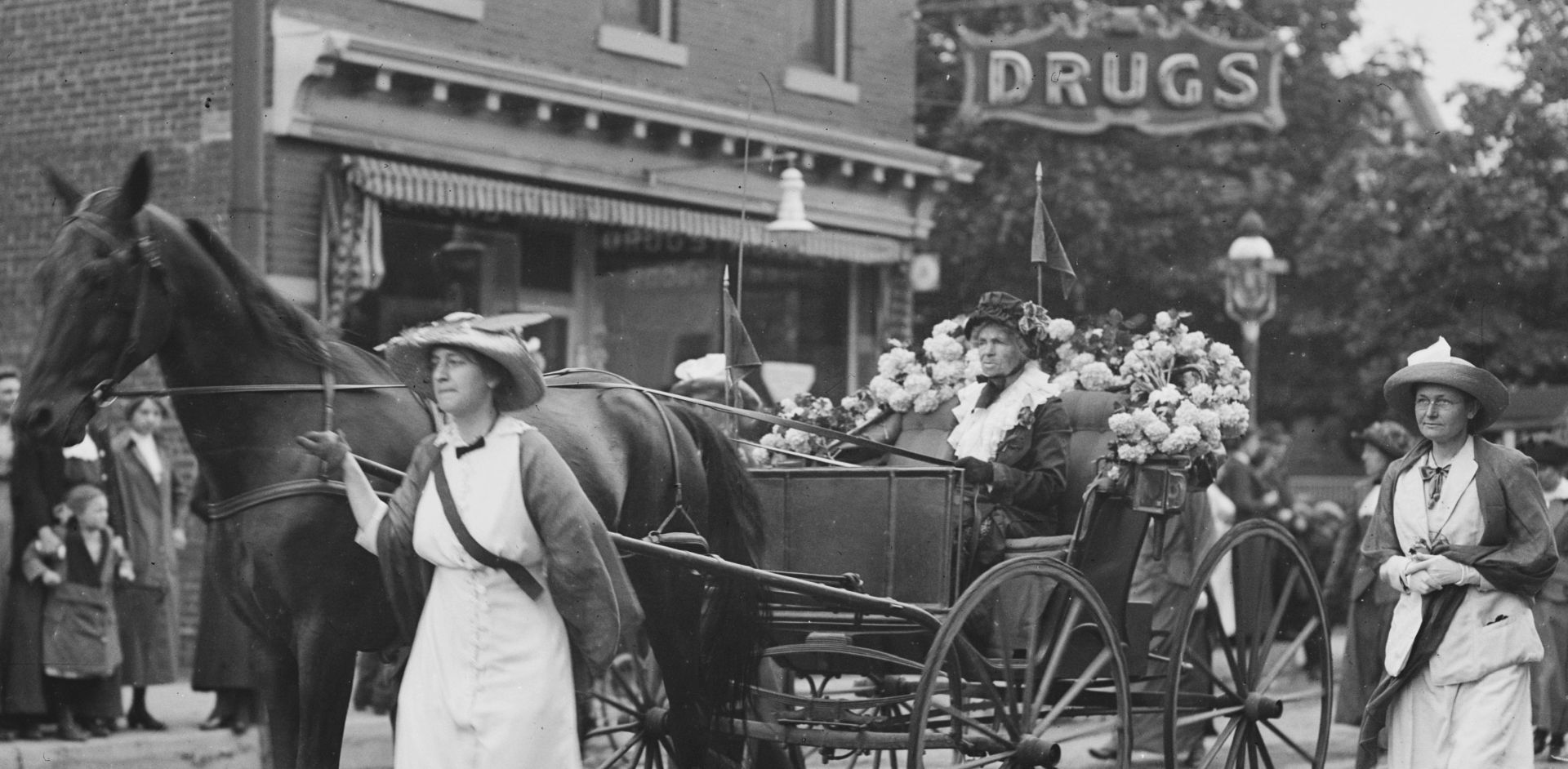
Wilson won with 41.6% of the popular vote, and was the first Democrat elected since 1892, carrying five of six suffrage states. Women won suffrage in Arizona, Kansas, and Oregon. In June 1913, Illinois would pass “presidential suffrage,” which allowed women to vote only for president, thereby becoming the first suffrage state east of the Mississippi.
Even though a federal amendment was not a priority, in December 1912, Harriet Blatch and Jane Addams, founder of Hull House, proposed that Alice Paul, Lucy Burns, and Crystal Eastman be appointed to NAWSA’s Congressional Committee in Washington. Paul, 27, lobbied for the post. The board tried to rein in her enthusiasm by insisting that she raise the money needed for the committee’s working and living expenses.
Alice Paul represented the third generation of suffrage leaders. The “New Suffragists” had graduate degrees and were more militant, more career-oriented, and more likely to be unmarried. Paul generated passionate loyalty among her peers. Doris Stevens later compared her to Vladimir Lenin: “cool, practical, rational.” Maud Younger, the founder of a union for waitresses, praised Paul’s self-sacrifice and “indomitable will.” Alice Paul resisted “siding with the old fogeys,” whom Doris Stevens, 26, dismissed as “the Dear Ladies.” Lumped among them, Carrie Catt may have recalled when Susan Anthony remarked that “every young woman was convinced she could have won suffrage long before, had she been in charge. “
By early 1913, the major players were on stage for a renewed fight for a federal amendment. President-elect Wilson, a Northern governor with Southern roots, was a dashing but disdainful leading man. As a Democrat who was sensitive to regional and racial politics, he argued that suffrage was a matter of states’ rights. Anna Howard Shaw, the NAWSA president, an aging diva, faltered. Her understudy, Carrie Chapman Catt, directed her energies toward winning in New York. Alice Paul, the ingénue, had moved to Washington, DC, ready to produce a theatrical tour de force.
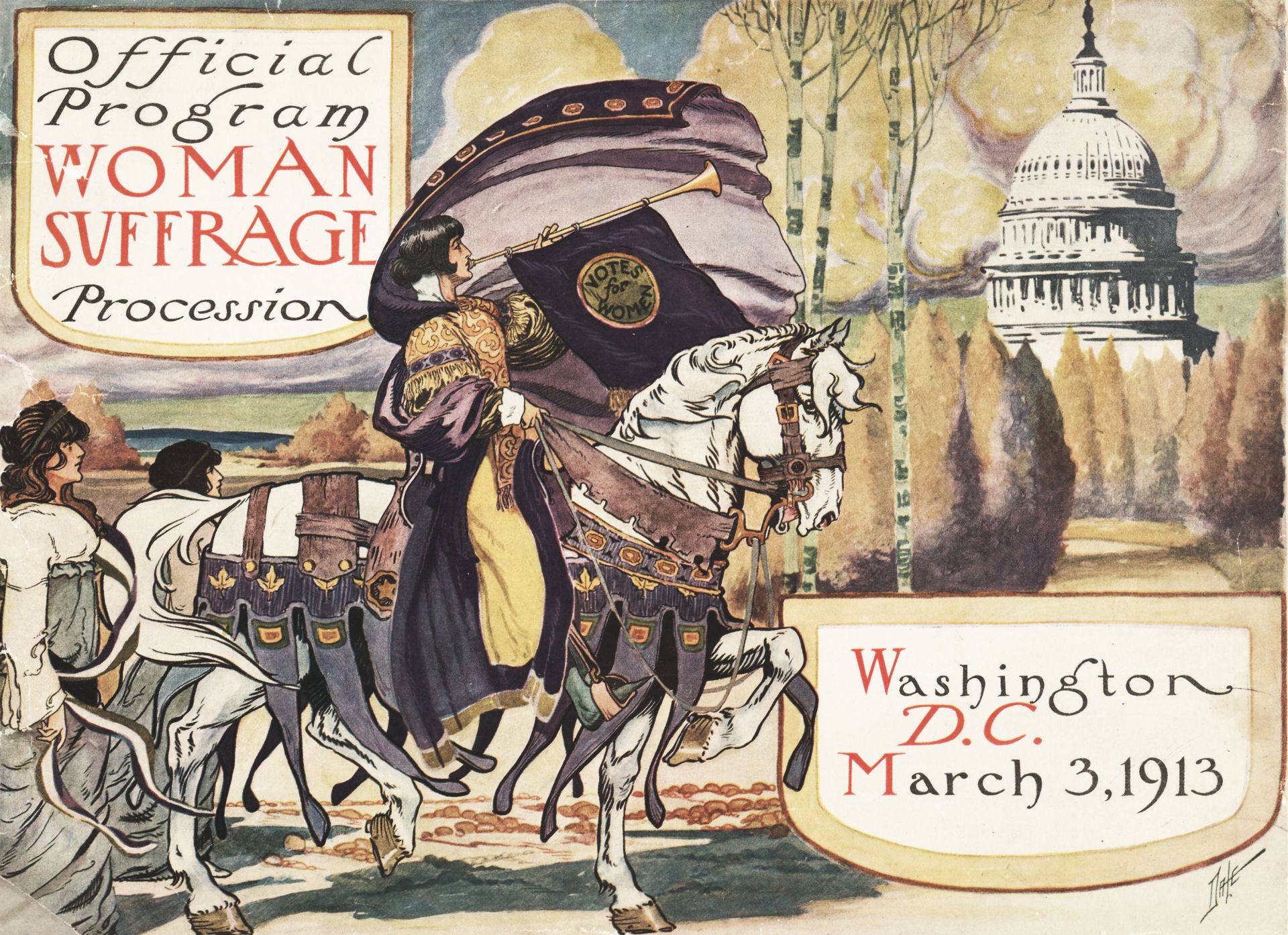
On January 2, 1913, Ms. Paul rented a basement and made it her headquarters at 1420 F Street, NW. Her Congressional committee included her close friend Lucy Burns, another Pankhurst veteran, whom she had met when both were arrested in London; Crystal Eastman, a Vassar ‘03 classmate of Burns and a socialist; Mary Beard, an academic; and the Philadelphia widow Dora Kelley Lewis, an effective fundraiser.
They raised more than enough money to cover the $14,906 cost of the parade, secured the necessary permits, and staged a spectacle.
There had never been a women’s parade in Washington. Approvals by executive, Congressional, and District officials were required. Streetcar service had to be shut down for two hours. Congressional wives who were NAWSA allies helped Paul win unprecedented access to official sites, including the south steps of the Treasury Building.
Police Superintendent Richard Sylvester did not think Pennsylvania Avenue was appropriate for ladies because it was lined with bars and brothels. He offered 16th Street, but Alice Paul wanted the big, bawdy crowd that commercial and government buildings would produce, in addition to spectators who were in town for the inauguration. It would take endorsements from the Chamber of Commerce, the Washington Board of Trade, the Senate District Committee, the Inaugural Committee, the city’s major newspapers, and pressure from President Taft to secure the grudging agreement of the police superintendent.
Paul had an unexpected gift for public theater. To signal that women would bring harmony and refinement to public life, every element was staged to be visually appealing. It was rumored that suffragists would pay pretty girls two dollars to participate, while anti-suffragists offered three dollars if they would stay home. Organizers encouraged color coordination. Artists, musicians, actresses, and writers were to wear shades of red. Professional women came in shades of blue: navy for social workers, light blue for librarians. Nurses wore their uniforms; college professors, students, and alumni wore academic gowns.
Everybody else wore white, with purple and gold sashes. The colors represented loyalty (blue/purple), purity (white), and a new dawn (yellow).
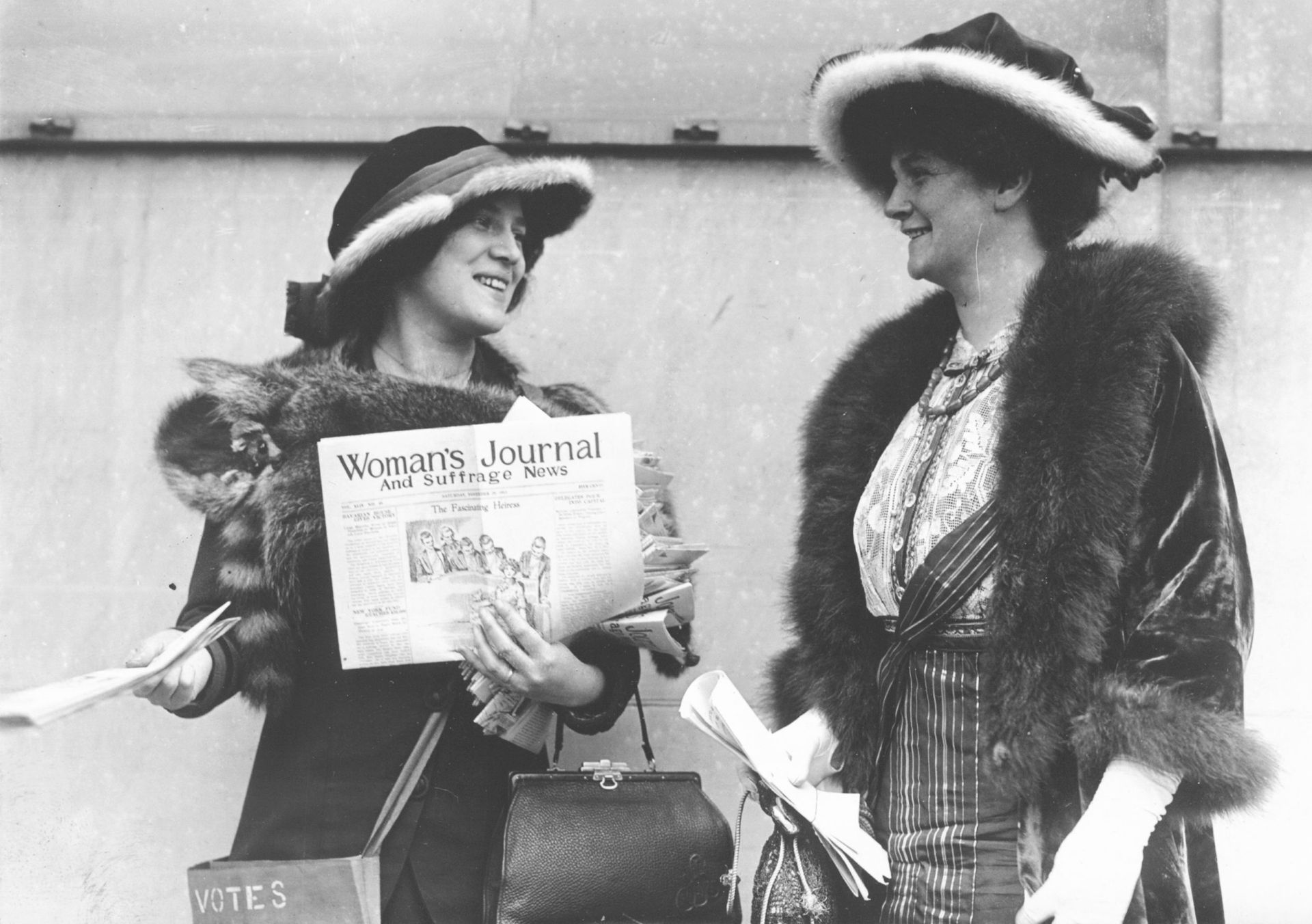
A 20-page program listed the order of march: the grand marshal; heralds on horseback; Shaw and the NAWSA leaders; Catt with the international representatives; suffrage “Pioneers,” women farmers, homemakers, nurses, academics, lawyers, doctors, pharmacists, and clerks. Businesswomen, teachers, social workers, librarians, writers, artists, actresses, and musicians followed. One section was for “un-uniformed marchers.” Congressional wives led state delegations, those that had passed suffrage ahead of those that had not, followed by a section for men, and, at the back, not included in the program, "colored" women. Marchers assembled on side streets, ready to fall into line. Grand Marshal Burleson gave the order to start at 3:24 PM. It was a sunny, breezy Monday.
A grandstand had been built across from the south steps of the Treasury Building. An audience of 20,000, among them, outgoing First Lady Helen Taft and Helen Keller, gathered at 3:30 PM to watch the theatrics. The figure of “Columbia” appeared first, at the top of the steps, in a red, white, and blue gown, breastplate, and plumed helmet, while a small orchestra played the “Star-Spangled Banner.” Blue-robed “Justice” carried the scales. “Charity” entered on a carpet of rose petals. “Liberty” followed the “Triumphal March” from Aida and “Peace” released a dove. “Hope” joined 100 dancing children dressed in rainbow hues. The New York Times described it as “one of the most impressively beautiful spectacles ever staged in this country.” With trumpets sounding, the women froze in place, a tableau vivant, to await the oncoming parade.
Alice Paul’s emphasis on harmony was undercut by internal acrimony and external attacks. There were fights about the dress code, the floats, fund accounting, and participation, specifically by African American women. The Delta Sigma Theta sorority, newly formed at Howard University, asked to march with the college contingent. They considered themselves “warriors for their race.” Another request came from Mary Church Terrell, NACW president emerita. Having pursued a “Southern strategy” of segregation and white supremacy since the 1890s, NAWSA was reluctant to integrate the ranks.
First, Ms. Paul excluded all non-whites: “We are not making any effort to organize the colored women as such, any more than we are endeavoring to organize Indian women or the women of any other race.” Then she assigned black women to the end of the line. Eventually, she decided that black women would be less visible if they were “scattered among some of the northern delegations if the other members feel no objection to walking beside them.” Whether that condescending concession was Paul’s idea or her capitulation to resistance by black suffragists is unknown.
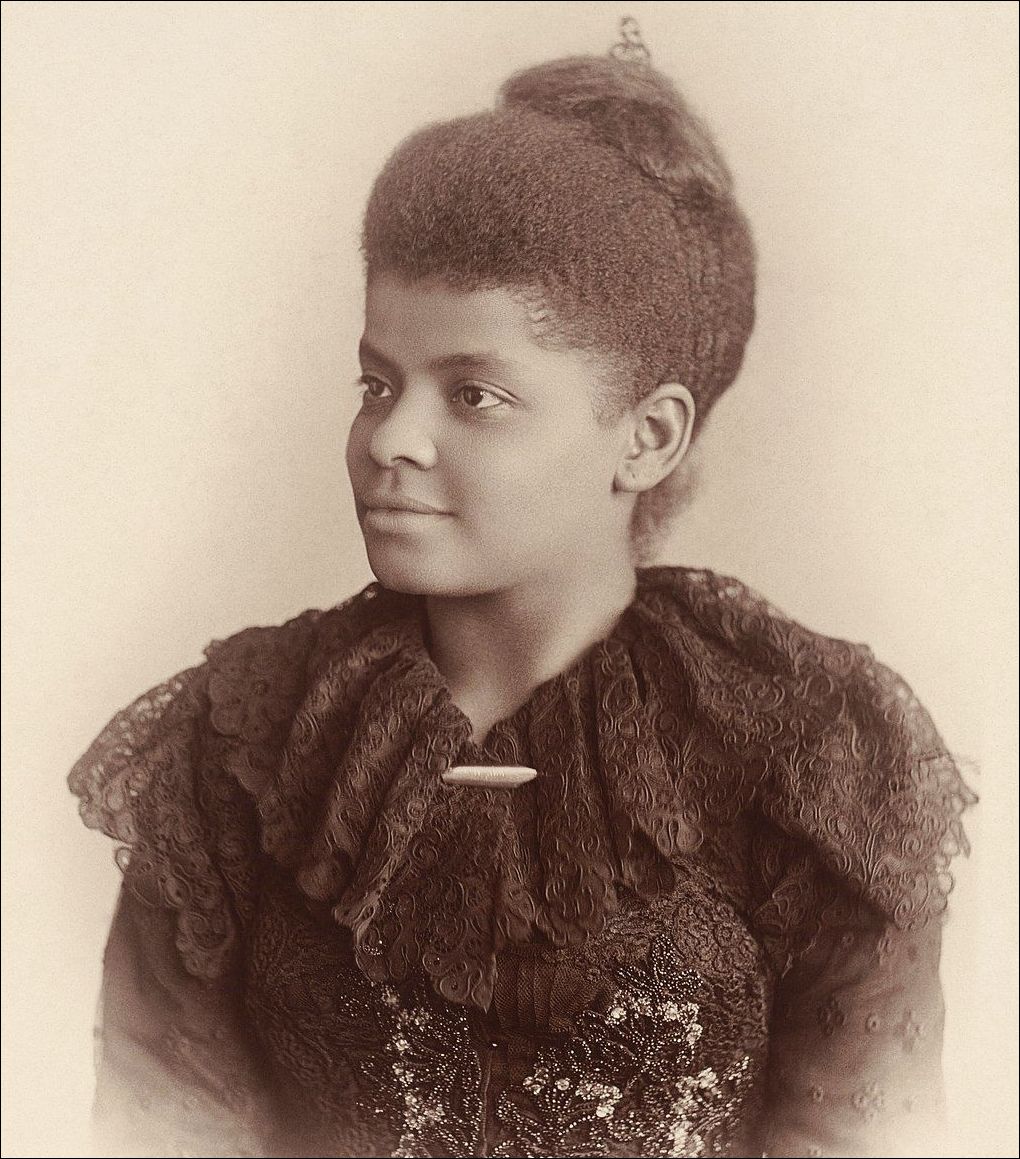
Fifty years after the Emancipation Proclamation, black leaders opposed efforts to diminish their participation. Ida B. Wells came to Washington as a member of the Illinois Equal Suffrage Association, a NAWSA affiliate, and founder of the Alpha Club, the earliest African American suffrage organization. The day before the march, Alice Stone Blackwell, editor of NAWSA’s Woman’s Journal and the only child of abolitionists Lucy Stone and Henry Blackwell, insisted that Illinois keep its delegation white. She ordered Wells to march in the colored section. Instead, after the march began, Wells slipped into the Illinois ranks from the sidewalk, where she was photographed by the Chicago Tribune. One source placed the light-skinned Terrell with the Deltas, who had made her an honorary member.
The April 1913 issue of The Crisis, published by the NAACP, counted 42 women in the colored section, including 22 Deltas, wearing caps and gowns, escorted by male chaperones. The sorority was the only African American women’s organization to march together. “The Woman’s Suffrage party had a hard time settling the status of Negroes in the Washington parade,” wrote editor W.E.B. Du Bois, with considerable understatement. Alice Paul’s response demonstrated the racism within NAWSA and the nation.
Threatening all the marchers was a huge crowd of white men. Spectators swarmed off the sidewalks to berate the women and block their path. A phalanx of 700 policemen, more than had been assigned to any previous public event, including 50 on horseback, plus men in police cars, tried to clear the route. They could not hold back the crowd, which was estimated at 500,000. Women were harassed, slapped, tripped, shoved, and grabbed.
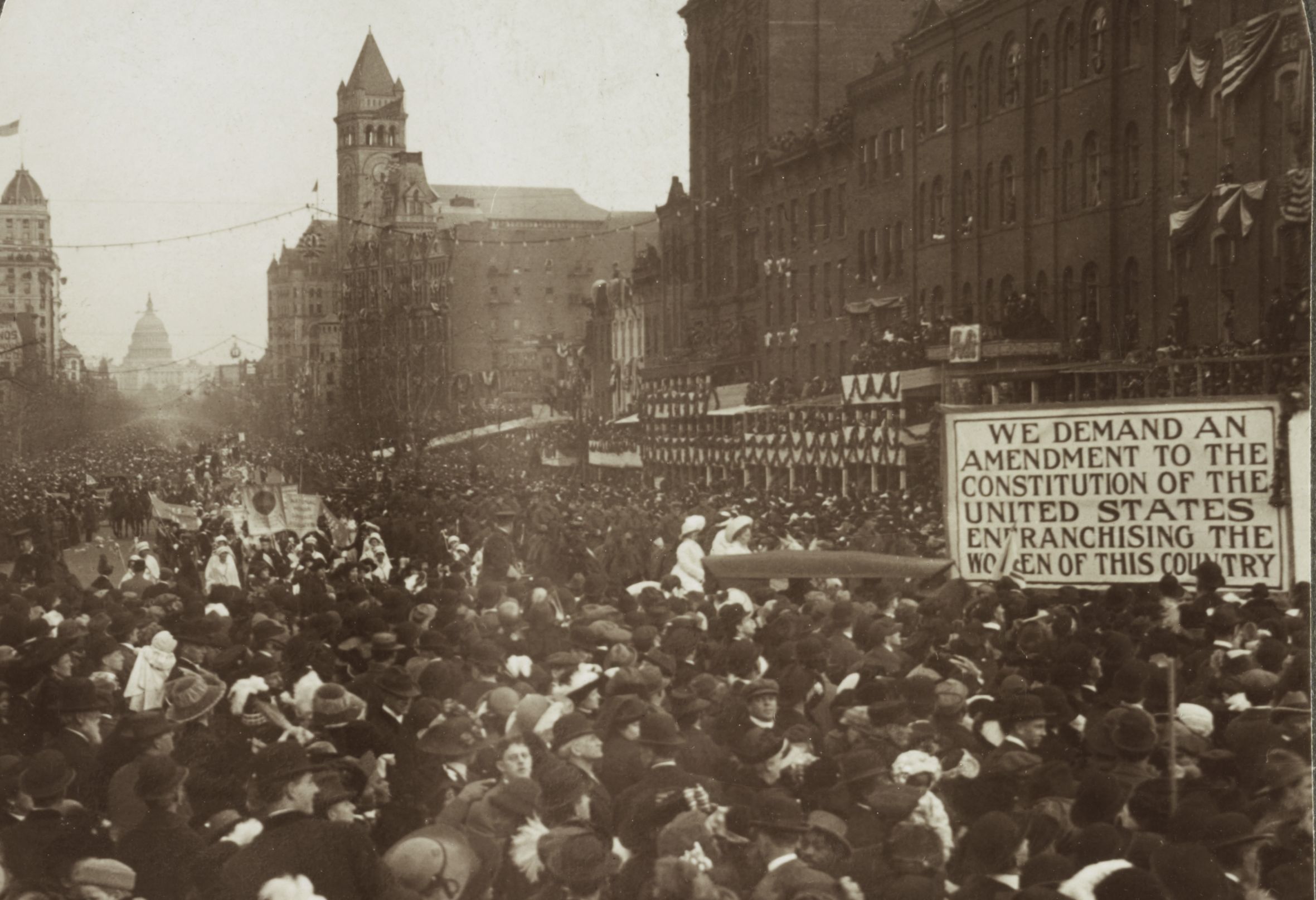
It took more than an hour to move the first four blocks. Boy Scouts and young men from the Maryland Agricultural College (now the University of Maryland, College Park) locked arms and formed a wedge so the women could proceed single-file. “Five thousand Women . . . fought . . . foot by foot,” reported the Washington Post. “Rowdies Slap and Spit on Weeping Suffragettes” disclosed the Rocky Mountain News. “Passing through two walls of antagonistic humanity, women suffered insult and closed their ears to jibes and jeers. Few faltered,” detailed another report.
Ambulances could not reach the injured. A Jewish daily claimed that 25 lost children spent the night in police stations. Eighteen men asked police to find their wives. Secretary of War Henry Stimson dispatched a cavalry detachment from Fort Myer, across the Potomac River in Virginia, to restore order. At the Treasury Building, women abandoned their tableaux and moved inside.
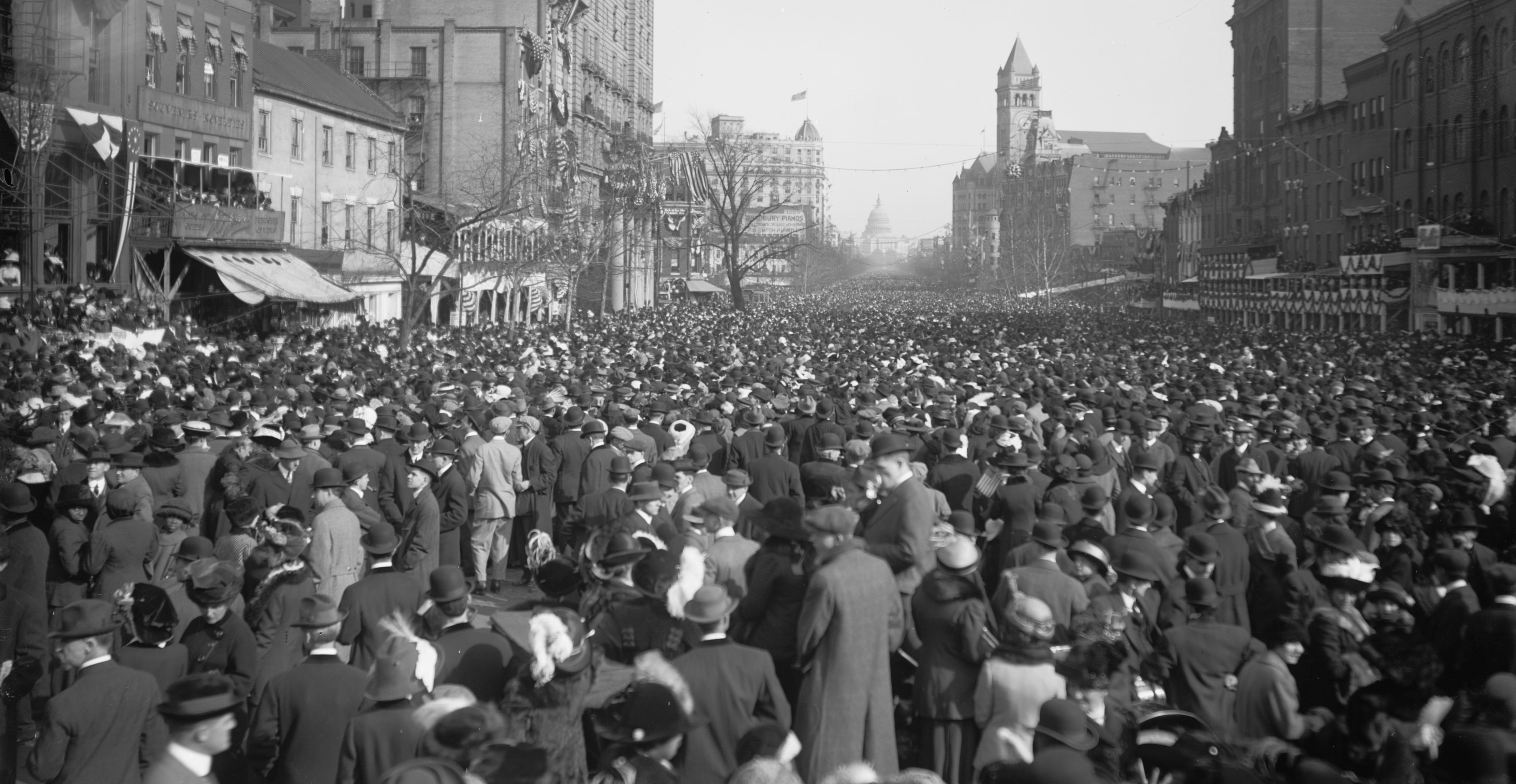
That evening, survivors of the melee, “freezing, filthy and furious,” assembled to condemn the chaos and blame the police. Weeks later, a Senate committee heard from 150 witnesses. The investigation exonerated Superintendent Sylvester and it prolonged publicity about suffrage.
Meanwhile, President-elect Wilson and his family arrived at Union Station, a few blocks away from Pennsylvania Avenue. Escorted by Princeton undergraduates, Wilson took another route to his hotel. Asked where everyone was, a policeman responded, “at the suffrage parade.”
The next day, the new president was driven down a peaceful, police-lined Pennsylvania Avenue. He had refused to allow any women to participate in his inaugural parade. Within weeks of his taking office, suffragists besieged him. The women found Wilson condescending; he found them disrespectful. Wilson was not “a woman suffrage man. “
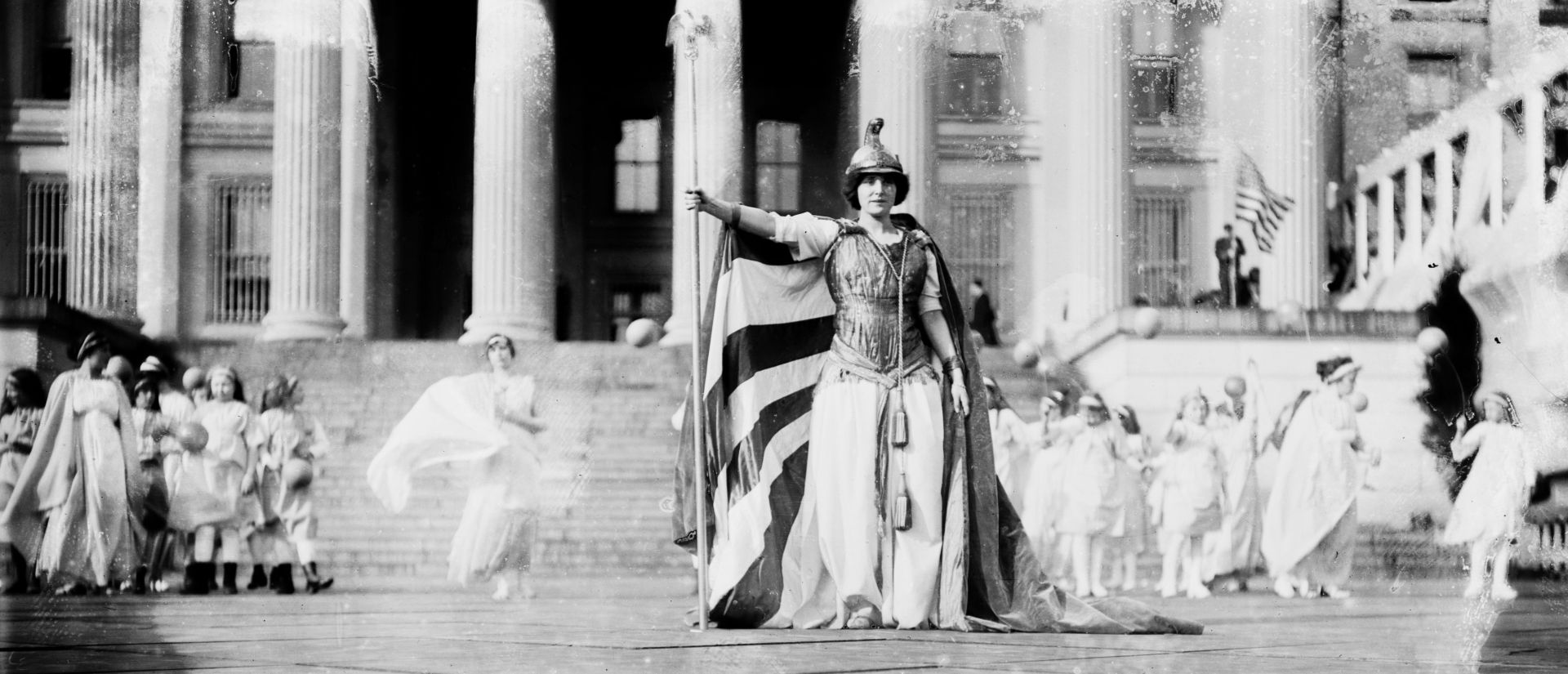
No one had anticipated the impact of the march. It was a brilliant public-relations coup. Press and newsreel coverage was sensational. “Capitol Mobs Make Converts to Suffrage” crowed The New York Tribune. “Parade Struggles to Victory, Despite Disgraceful Scenes, Nation Aroused by Open Insults to Women — Cause Wins Popular Sympathy” proclaimed NAWSA’s Woman’s Journal. Many stories used the size of the march and its audience to gauge its importance. The New York Herald estimated at least 225,000 spectators, “a greater crowd than at any inaugural.”
The 1913 women’s march put suffrage on a resistant president’s agenda. It focused NAWSA’s reluctant attention on a federal amendment. It alarmed and energized the amendment’s enemies, rallied its diverse supporters, underscored the racial schism among suffragists, cemented the generation gap between younger and older leaders, introduced street theater as a tactic, and elevated Alice Paul as a fierce partisan.

